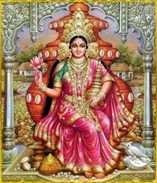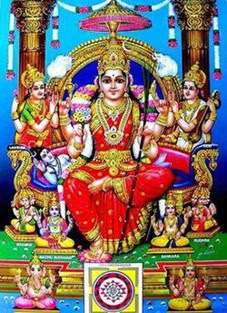In Namas 381 to 474, the Divine Mother’s Jnana Yoga worship methods are discussed in detail.
The Divine Mother is ever compassionate to Her devotees.
Klinna means melting or being in wet condition. The old saying is that a hard-hearted person has no wetness or softness or kindness in him for others. A healthy person has glowing skin; naturally, humans have soft glowing skin in their growing stage of life. The Divine Mother is ever soft or kindhearted. She rules the universe strictly, yet She is very compassionate; She is storehouse of kindness. Her motherly kindness is ever there for Her devotees. That means that even with strict ruling, She shows Her kindness. She is keen to mature the souls through Her compassion, She is called Nitya klinna.
Another way of saying is that Her heart is always wet or soft for Her devotees; Her compassion is there eternally.
Nitya klinna is the deity worshipped during Moon growing phase third night and on Moon waning phase thirteenth night. Garuda Purana says that She is Tripurasundari, the bestower of good luck and liberation from samsara cycle for Her devotees.
Sighting growing phases third night Moon is long standing tradition among Hindus; other religions such as Muslims also consider that Moon sighting on that growing phase third night as an auspicious thing.
The Divine Mother as
RajaRajeswari
bestowing Her Compassion to her devotees.
C N Nachiappan
Singapore, 16 February 2021.
References:
1.
The Thousand Names of the Divine Mother published in English by
Mata Amritanandamayi Center, San Ramon, California, USA, with Commentary by T.
V Narayana Menon
2.
Shri Lalitha Sahasranama Stostram published in Tamil by N.
Ramaswami Iyer charities’ societies, Trichirapalli, India, with Commentary by
C. V. Radhakrishna Sastry.
3.
The Lalitha Sahasranamam published in Tamil by Shri Ramakrishna
Thapovanam, Thiruipparaithurai, Trichy District, Tamilnadu, India with
commentary by Shrimath Swami Chithbavandar














